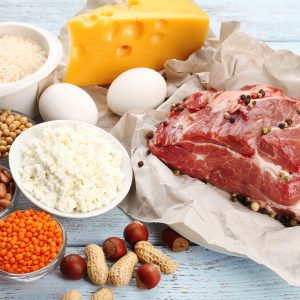When we consume foods with protein, the proteins are broken down into amino acids which form the building blocks of muscles. As we get older our muscle stores naturally decline so it is important that we eat and exercise in a way to attenuate the age related loses. It is possible to increase muscle mass at any age through adequate protein intake and resistance training exercises.
How much protein should I eat?
It is recommended that older adults consume 0.8g protein/kg body weight per day to assist maintenance of muscle stores and bone health. More is required if you have been unwell or have healing wounds (e.g. following surgery).
When should I eat it?
Timing of protein intake is important. A little bit in each meal (rather than just a large amount at the end of the day) will give the best results for satiety and muscle growth. Eating protein around your exercise time is vital. E.g. breakfast with eggs, milk, cheese or yoghurt, smoothies, snack of nuts or cheese. Not just a 200g steak at the end of the day (which will contribute ~65g protein – more than the daily requirement for some!)
Do I get enough protein in my diet?
This is not something that is commonly lacking in the Australian diet. For some, it may be a source of excess calories contributing to unwanted weight gain. The Dietary Guidelines recommend lean protein sources for cardiac health, for example, legumes, eggs, meat with visible fat removed and low fat dairy foods. A 51+ year old person should consume 2 serves of meat or meat alternatives per day. This is equal to 180g red meat, 200g poultry or230g fish (raw weights). There is also protein in eggs, legumes, nuts, tofu and dairy.

